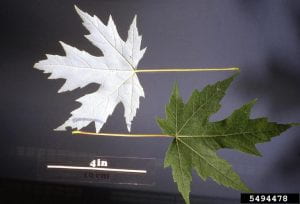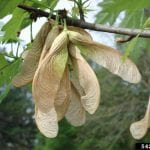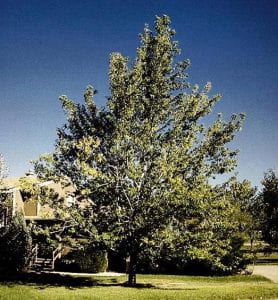By Cecille Jones, Monroe Master Gardener Volunteer
This article appeared in the March 2021 Issue of Gardening in Orange County.
The advice to plant the right tree in the right place couldn’t apply more to our tree of the month – the silver maple.
If you have space in your property and you want a fast-growing shade tree, the silver maple (Acer saccharinum) might be for you. The name Acer comes from the Celtic, ac, meaning hard, denoting the dense wood of the maple genus. The species name, saccharinum, means sugar because of the tree’s sap-producing quality (although this is not the best species for making our favored breakfast syrup.)
 A species native to eastern North America, the silver maple features 3 – 6” leaves with 5 lobes separated by notably deep, narrow sinuses. Its common name was derived from the fact that its leaves are dark green on top but silvery-white on the underside. Most people delight in seeing the silver underbellies of its leaves shimmer in the sun at the slightest puff of wind during spring and summer.
A species native to eastern North America, the silver maple features 3 – 6” leaves with 5 lobes separated by notably deep, narrow sinuses. Its common name was derived from the fact that its leaves are dark green on top but silvery-white on the underside. Most people delight in seeing the silver underbellies of its leaves shimmer in the sun at the slightest puff of wind during spring and summer.
In the fall, the leaves turn pale yellow. Come springtime, they produce red, yellow and silver clusters of small flowers. At over 3” long, the winged seeds of silver maples are the largest of all native maples.
 These trees have wildlife value. Think of beavers finding them delicious, squirrels feasting on their buds, and ducks and other birds using them as nesting sites.
These trees have wildlife value. Think of beavers finding them delicious, squirrels feasting on their buds, and ducks and other birds using them as nesting sites.
The silver maple holds the distinction of being the twentieth most commonly planted shade tree in American gardens. It grows fast, provides shade quickly, and can adapt to a wide variety of soil conditions.
Silver maples can grow anywhere in Zones 3 to 7. It can survive seasonal inundation and poor soil. As a wetland tree (it’s also called swamp maple), it prefers deep, moist acidic soil. Once established however, it can tolerate drought.
 Full sun to partial shade are best for this tree. It prefers a minimum of four hours of direct, unfiltered sunlight each day. Silver maples can reach between 50’ to 80’ in height and spread from 35’ to 50’ at maturity. Its growth rate could be as much as two feet annually.
Full sun to partial shade are best for this tree. It prefers a minimum of four hours of direct, unfiltered sunlight each day. Silver maples can reach between 50’ to 80’ in height and spread from 35’ to 50’ at maturity. Its growth rate could be as much as two feet annually.
Silver maples are not orderly trees with symmetrical form. Their trunks can become massive, and they have a wide spreading but shallow root system. Don’t expect plants to thrive beneath them.
More importantly, remember to plant this tree well away from your house, foundation, sidewalk and sewer lines where its dense roots can wreak havoc. Also, beware that silver maples have a reputation for having branches that break easily during ice and wind storms.
Just like other trees, silver maples have their good and bad points. That’s why planting this native tree in the right place is key to your success.
Resources
Acer saccharinum – Cornell University Woody Plant Database
Acer saccharinum – University of Connecticut Plant Database
Acer saccharinum – Virginia Tech Dendrology
VIDEO: Silver Maple – SUNY Environmental Science and Forestry
